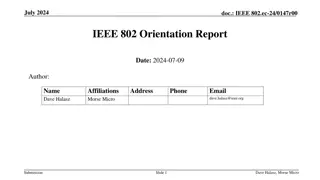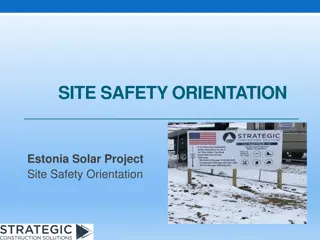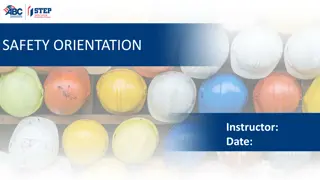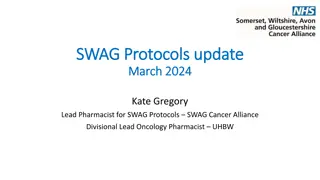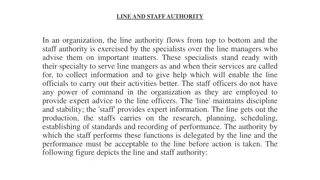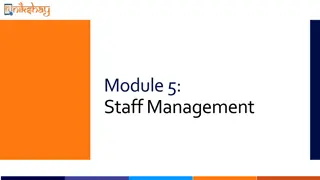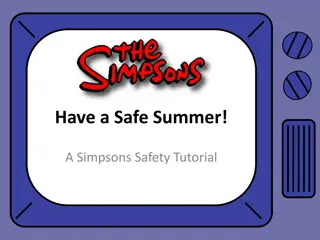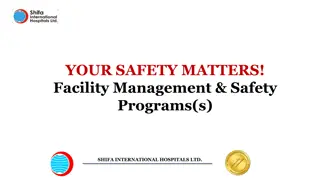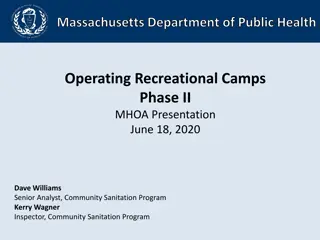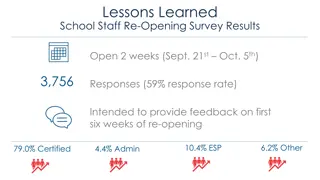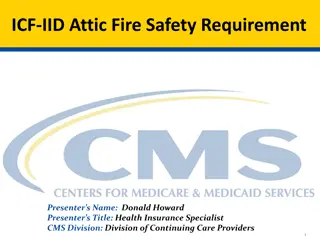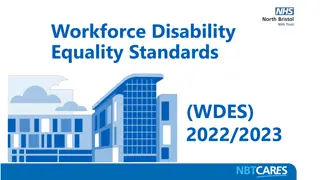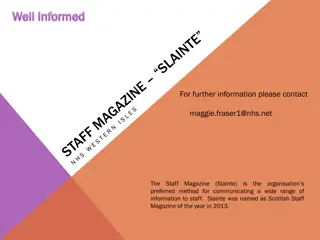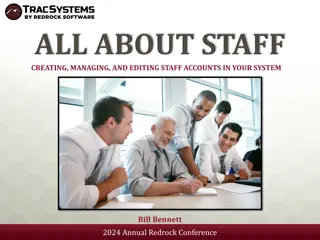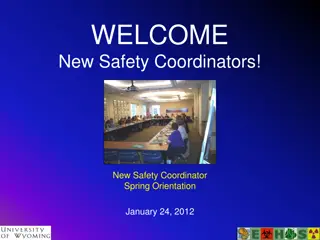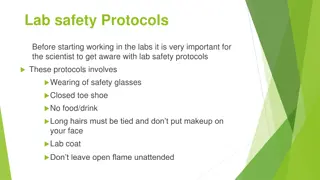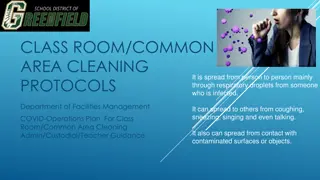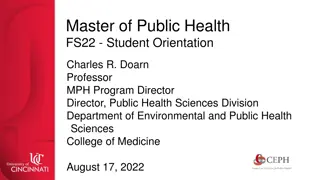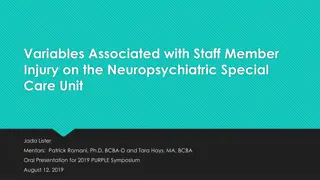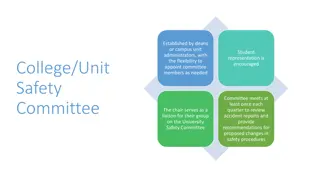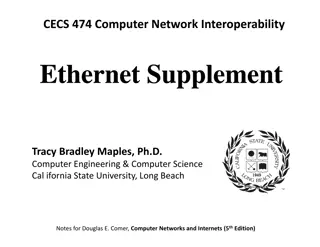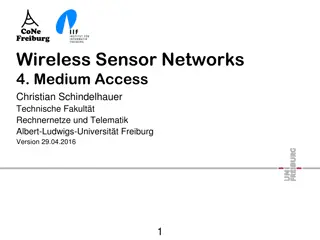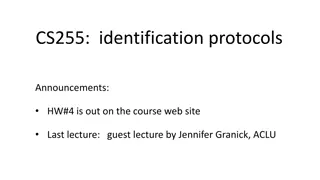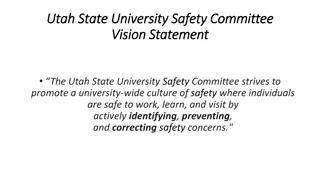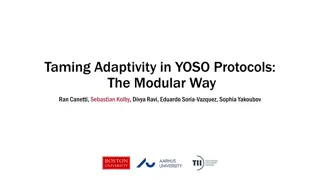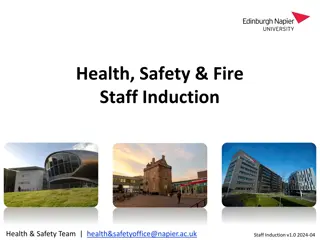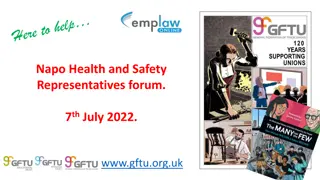Summer Staff Orientation Health and Safety Protocols
As we prepare to open summer school at two pilot locations, the health and safety of both staff and students are our top priority. We are implementing proven methods, DOE minimum standards, and recommended considerations to ensure a safe environment. Procedures include contactless pick-ups/drop-offs, symptom screenings, temperature checks, footwear sanitizing, and hand washing/sanitizing. Visual aids and detailed protocols are provided for a thorough understanding of the process.
Download Presentation

Please find below an Image/Link to download the presentation.
The content on the website is provided AS IS for your information and personal use only. It may not be sold, licensed, or shared on other websites without obtaining consent from the author. Download presentation by click this link. If you encounter any issues during the download, it is possible that the publisher has removed the file from their server.
E N D
Presentation Transcript
1 Summer Staff Orientation As we open summer school with two pilot locations, please be assured that your health and safety as well as our students is of paramount importance. We will be incorporating proven methods along with new DOE minimum standards as well as recommended considerations toward that end. This is an emerging, rapidly evolving situation and the NBOE will be following CDC updated information as it evolves, in addition to updated guidance from Executive Orders issued by the Governor s office and the DOE Road Back protocols. July 1, 2020
2 Summer Staff Orientation Ingress Procedure For all in-person Summer School Sites: This location is a contactless summer school site. All pick-ups and drop-offs will occur outside. Only staff assigned to this location will be permitted in, barring any emergencies Parents should ensure that anyone escorting their child to school is wearing a mask when picking up and dropping off their children. Students should all have on masks when being dropped off for school. A tent will be set up outside to receive students prior to entering the building. There will be 3 stations to monitor the process: the lines to stand before you enter the tent, the tent where all screenings will take place, and the escorting of children into the building.
3 Summer Staff Orientation Ingress Procedure Cont d Students will undergo a four step process prior to entering the building which includes the following: Step 1: Symptoms Screening Students will be asked a series of questions regarding their health. Depending on the students response, they will move to the next step in the process. Temperature Check - If the student passes the symptoms screening, they will then have their temperature checked. Students with a temperature of 100.4 degrees or higher, will not be permitted into the building. Footwear Sanitizing - Students will then stand in a rubber maid tub to sanitize and disinfect their shoes. Please note students must wear closed toe shoes). Hand Washing/Sanitizing - Students will be provided hand sanitizer or will wash their hands with soap and water before being escorted into the building. Parents or anyone escorting their child are encouraged to assist in each step of this process. Step 2: Step 3: Step 4:
4 Summer Staff Orientation Ingress Procedure Set-up
5 Summer Staff Orientation Step 1: Symptoms Screening
6 Summer Staff Orientation Step 2: Temperature Check
7 Summer Staff Orientation Step 3: Footwear Sanitizing
8 Summer Staff Orientation Step 4: Hand Washing/Sanitizing
9 Cleaning & Sanitizing Protocols During COVID CLEANING TOOLS AND PROTOCOLS
10 CDC , DOE & NJ Department of Health COVID-19 Guidance for school occupancies are being followed. COVID-19: Information for Schools Increase frequency of cleaning all surfaces, including walls (to the appropriate height based on age of students). Routinely clean and disinfect surfaces and objects that are frequently touched. Drinking fountains are being turned off, staff and students should bring their own water. Cleaning/sanitizing checklist will be completed by the personnel responsible for the cleaning. We will close off areas used by a sick person and not use before cleaning and disinfection.
11 Re-Opening Disinfecting & Sanitizing Program Due to the COVID Pandemic, Director Wali Thomas will have specially trained district staff utilizing specialized equipment and products to ensure proper sanitizing and disinfecting protocols up to district standards, CDC and DOE guidelines and recommendations are being met. All surfaces will be cleaned with detergent/hydrogen peroxide cleaner or a product approved by the district for specific outbreaks, with additional dwell or contact to ensure sanitation. Electrostatic equipment and misting sprayers will be utilized to ensure the efficacy of the program.
12 NBOE is responding to the COVID outbreak and is taking special action to ensure Summer Schools are safe for our students and staff. While the district will implement measures and protocols to prepare for reopening, individual action and individual responsibility are necessary for the success of any measures implemented. Not only should you take action to protect yourself and your families, you should also take action to prevent the spread of the virus if you or anyone in your family becomes ill.
13 Please follow signage Do your part and talk to your students often about the importance of social distancing and hand washing.
14 Wash Your Hands Often & Use Sanitizer Foaming Hand Sanitizer will be Available Throughout your school and in your classroom. Kills 99.9% of germs Contains TWO ACTIVE GERM-KILLING INGREDIENTS: 70% Isopropyl Alcohol (CDC, EPA Recommended Levels) Benzalkonium Chloride Encapsulated technology keeps alcohol active and working longer Made with organic essential oils to keep hands moisturized. Foam provides more volume compared to gel.
15 On-Going High Contact Surface Disinfecting Locker Room Benches Computer Keyboards Elevator Buttons Push Plates Desktops Faucet Knobs Toilet Stall Doors and Latches Doorknobs Fitness Equipment Door Pulls Flush Valves Bathroom fixtures Drinking Fountain Bubblers and Faucets Hand Rails Kronos biometric readers Hand Towel Dispensers Levers Student Desks & Chairs Light Switches Lunchroom tables and chairs if used. Telephone Handsets
16 Enviro Solutions 364 KILLS NOROVIRUS IN JUST 5 MINUTES! One-step, fast contact-time disinfectant Provides superior cost-performance benefits Contains a neutral pH that is non- staining, non-corrosive to equipment Easily handled and does not dull floor finishes EPA registered
17 We are using Electrostatic sprayers for fast and efficient disinfecting
18 PURTABS VIRAL DISINFECTANT-HOSPITAL GRADE DISINFECTANT Safer for people. Deadly for infectious agents.
19 Backpack sprayers allow for speedy application of disinfectants.
20 Use of misting sprayers to apply disinfectant.
21 Automated equipment supplements hands-on contact cleaning.
22 Electrostatic sprayers contact all surfaces by applying a positive charge to disinfectant.
23 The entire building is treated quickly.
24 Continuous Disinfecting Program
25 Every classroom will be supplied with a cleaning kit to help you keep your classroom tidy and sanitary during the school day.
26 So how do we know how we re doing? Clean-Trace Hygiene Monitoring System 3M Repeatability and reliability two necessary aspects in any ATP testing system. In a study comparing 9 ATP systems, the 3M Clean-Trace Hygiene Monitoring and Management System was the only ATP system that produced acceptable results at all times and temperatures.
27 There is evidence that HVAC operations may help decrease people's exposure to airborne pathogens that spread COVID-19 and other illnesses. NBOE has increased air ventilation by maximizing the introduction of fresh air and reducing air recirculation to the extent possible. Air filter MERV ratings will be increased to improve removal of smaller particulates in the air stream. Air filters will be changed more frequently. Air handlers will be set to run 24/7 instead of non-occupied mode to continuously introduce fresh air into the building around the clock. Staff are encouraged to keep windows open slightly to increase fresh air in air-conditioned rooms to the extent possible. Portable A/C units are being deployed to 13th Avenue.
28 In the event a COVID positive individual is identified through testing, we will deploy Air purifiers with HEPA filtration as well as Hydroxyl Air Processors to treat specific locations. The CDC believes the virus is mainly transmitted by person-to-person contact; however these units will be deployed if needed.
29 3-Sided Plastic Classroom Dividers for Desk - Also known as sneeze or cough guards, are optically clear plastic dividers which may be used to separate students in classrooms to help maintain social distancing. The NBOE is testing several prototypes and will be implementing as they arrive.
30 Mask-up, wash-up, maintain social distancing and do your part to limit the virus s spread. Practice routine cleaning and disinfection of frequently touched objects and surfaces, especially your smartphones. Avoid using other employees phones, desks, offices, or other work tools and equipment, when possible. Clean and disinfect them before and after use. Practice social distancing by avoiding large group meetings and maintaining distance (at least 6 feet) from others when possible.
31 Bloodborne Pathogens and COVID-19 Training 2020
32 Why should school employees be concerned about bloodborne pathogens? #1 Blood from an infected person can potentially infect others: - if sprayed or splashed into mouth, nose , eyes or on non-intact skin - through needlesticks or cuts from sharp objects contaminated with an infected person s blood #2 The outcome of being infected with HIV, HBV or HCV is serious !!!
NJ PEOSH requires that public schools comply with the Bloodborne Pathogens Standard. 33 Copies of the PEOSH BBP standard and the required Exposure Control Plan are available in all the Nurses Offices. District Bloodborne Pathogens Coordinator: _Office of Health Services Phone: _973-733-7150
34 The Major Bloodborne Pathogens --- infectious materials in blood that can cause disease in humans Human Hepatitis B Virus Immunodeficiency Virus Hepatitis C Virus
35 Signs & Symptoms Go to fullsize image
36 S&S of Disease AIDS Hepatitis Swollen lymph nodes Lack of appetite Chronic diarrhea Weight loss Fever Fatigue Lack of appetite Vague abdominal pain Nausea Vomiting Jaundice Fever
37 Most exposures do not result in infection. Risk varies according to: Infectious agent involved Type of exposure Amount of blood Amount of virus in source blood
38 Use of Needles and Medical Sharps in the Newark Public School District Limited to disposal of insulin syringes in the Nurses Offices All sharps must be placed in puncture-proof biohazard containers District has evaluated and is using new safe needle devices to further reduce the risk of needle sticks - syringes with retractable needles
39 Chance of infection after a contaminated needlestick exposure Chance of Infection 6 30 out of 100 people 3 10 out of 100 people Less than 1 out of 100 people Virus HBV HCV HIV
40 Is there a vaccine to prevent infection? Hepatitis B Vaccine Hepatitis B? YES PractiVaccineB_big Hepatitis C? NO HIV? NO Safe 90% effective Series of 3 shots given in the arm
Hep%2520B%2520Vaccine 41 Hepatitis B Vaccine must be made available to all employees with occupational exposure within 10 days of assignment on work time and at no cost to the employee.
Newark Board of Education Job Classifications with Occupational Exposure to BBPs 42 School Nurses & Physicians Custodians
43 Occupational Exposure to BBPs It is important that every school employee understands the dangers of infection and safe practices to minimize exposure. The Newark Board of Education provides initial and annual training to all employees considered at risk of exposure.
44 Goals of Newark Board of Education s Exposure Control Plan #1 Prevent exposures #2 Treat exposures that do occur in a timely way according to the latest CDC guidelines
45 The most effective practice for preventing exposures and reducing transmission of infectious agents? Handwashing !
46 Practice Universal or Standard Precautions #1 Treat all blood and the following body fluids as if potentially infectious Blood products Fluids surrounding brain, spine, heart and joints Any body fluid visibly contaminated with blood Fluids in the chest and abdomen Fluid in the uterus of a pregnant woman #2 Tears, saliva, sweat, vomitus, urine and feces do not pose a BBP risk unless they are contaminated with blood.
47 Use methods to contain or remove the hazard at the source: Safe needle devices that cover or retract the contaminated sharp before an exposure can occur Puncture- resistant containers for sharps are maintained in the nurse s office of each school Appropriate containers for materials saturated with blood
48 Are paper towels or latex gloves containing a few drops of blood considered regulated medical waste in NJ? NO. Paper towels or gloves that are not saturated with blood or a regulated body fluid and are not either dripping and soaked in or have dried or caked after having been saturated with such fluids are not regulated medical waste. www.state.nj.us/dep/dshw/rrtp/mwforms03/mwtrqasht.htm
49 Follow on-the-job procedures designed to reduce exposure #1 Have specific employees assigned to deal with BBP hazards - First aid by school nurse or person trained in BBP safety - Custodian responsible for blood and body fluid spills #2 Wear protective gloves when rendering first aid; wash hands immediately after removing gloves #3 Do not eat or drink in areas where there is a reasonable likelihood of exposure to blood or body fluids. #4 Dispose of needles and sharps in puncture-proof biohazard container; Use safe needle devices whenever possible
50 Provide / Utilize Personal Protective Equipment PPE Available Location -Nurses Offices -Custodians Office Closets - Every classroom has a kit which contains: gloves, 4x4 gauze, band-aids. - Custodians, grounds and maintenance closets Medical Gloves Utility Gloves Gowns, face shields, masks - Nurses Offices



